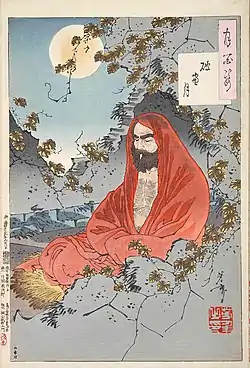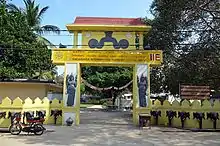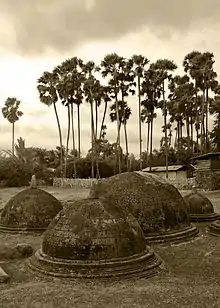Buddhism amongst Tamils
Buddhism amongst Tamils was historically found in Tamilakam and the Jaffna Peninsula.

India
Tamil Nadu
The heritage of the town of Nākappaṭṭinam is found in the Burmese historical text of the 3rd century BCE and gives evidence of a Budha Vihar built by the King Ashoka. An inscription from Anuradhapura, Sri Lanka dated to 2nd century BC records the association of Tamil merchants with Buddhist institution.[1]
For several centuries in the second millennium of the common era Buddhism among Tamils in Tamilaham and Ilam was neglected and virtually abandoned due to shifts in political patronage and the revivalism among non-Buddhist religions. According to A.J.V. Chandrakanthan who recently (2019) published an article about an 11th-century comparative work named VEERASOLIYAM, codifying Tamil and Sanskrit Philology and Poetics is a clear indicator of the prominence given to Buddhism in Tamil scholarship. However the pan Saiva revival in Tamilaham in the second half of the second millennium and the Vaishnava resurgence coupled with the Bhakti movement ushered in a new era of religious militancy that virtually eradicated Buddhism forever from the Tamil speaking regions of the South of India.
Various scholarly works dating back to the 5th, 6th and 7th century of the common era saw the birth of classical Tamil works composed by eminent Tamil poets with Buddhist philosophical themes and insights illustrate the impact that Buddhism had in the world of Tamil scholarship. One of the classical products of that period is the ancient Tamil Buddhist epic-poem Manimekalai by the celebrated poet Chithalai Chathanar is set in the town of Kaveripattanam.[2][3]
Ancient ruins of a 4th-5th-century Buddhist monastery, a Buddha statue, and a Buddhapada (footprint of the Buddha) were found in another section of the ancient city, now at Pallavanesvaram.[4]
Nākappaṭṭinam was a Buddhist centre of the 4th-5th century CE. Its stupa dates from this era. Buddhism disappeared from this city as of an unknown date but was revived as of the 9th century. (H.P.Ray, The Winds of Change, Delhi 1994, p. 142) In the 11th century, Chudamani Vihara was built by the Javanese king Sri Vijaya Soolamanivarman with the patronage of Raja Raja Chola I.[5] The "Animangalam Copperplate" of Kulothungachola notes that “Kasiba Thera” [Buddhist Monk] renovated the Buddhist temple in the 6th century with the help of Buddhist monks of "Naga Nadu". This "nagar annam vihar" later came to be known as "Nagananavihar. Buddhism flourished until the 15th century and the buildings of the vihara survived until the 18th century.
Kanchipuram is one of the oldest cities in South India, and was a city of learning for Tamil, Sanskrit, and Pali and was believed to be visited by Xuanzang. He visited the city in the 7th century and said that this city was 6 miles in circumference and that its people were famous for bravery and piety as well as for their love of justice and veneration for learning. He further recorded that Gautama Buddha had visited the place. It was during the reign of the Pallava dynasty from the 4th to the 9th centuries that Kanchipuram attained its limelight. The city served as the Pallava capital, and many of the known temples were built during their reign. According to Tamil tradition, the founder of Zen, Bodhidharma was born here,[6][7][note 1]. Great Buddhist scholars such as Dignāga, Buddhaghosa, Bodhisena and Dhammapala lived here too.
Sri Lanka
Jaffna peninsula



Nāka Tivu/ Nāka Natu was the name of the whole Jaffna Peninsula in some historical documents. There are number of Buddhist myths associated with the interactions of people of this historical place with Buddha.[12] This Nagadeepa Purana Viharaya was located close to the ancient Nainativu Nagapooshani Amman Temple of Nainativu, one of the Shakti Peethas.[13][14] The word Naga was sometimes written in early inscriptions as Nāya, as in Nāganika - this occurs in the Nanaghat inscription of 150 BCE.
The famous Vallipuram Buddha statue built with Dravidian sculptural traditions from Amaravathi village, Guntur district (Amaravati school) was found in excavations below the Hindu Temple. The language of the inscription is Tamil-Prakrit, which shares several similarities with script inscriptions used in Andhra at the time, when the Telugu Satavahana dynasty was at the height of its power and its 17th monarch Hāla (20-24 CE) married a princess from the island.[15][16] Peter Schalk writes, "Vallipuram has very rich archaeological remains that point at an early settlement. It was probably an emporium in the first centuries AD. […] From already dated stones with which we compare this Vallipuram statue, we can conclude that it falls in the period 3-4 century AD. During that period, the typical Amaravati-Buddha sculpture was developed."[17] The Buddha statue found here was given to King of Thailand by the then British Governor Henry Blake in 1906.
Indrapala argued for a flourishing pre-Christian Buddhist civilization in Jaffna, in agreement with Paranavithana, and Mudliyar C. Rasanayakam, Ancient Jaffna in an earlier work, 1965.
This place is similar to Nagapatnam where all Asian vessels used it as a stopover point and the Buddhist and Hindu Dagobas are just a resting and worshipping places for the sailors and international traders. .
A group of Dagobas situated close together at the Kadurugoda Vihara site in Kandarodai served as a monastery for Tamil monks and reflect the rise in popularity of Mahayana Buddhism amongst Jaffna Tamils and the Tamils of the ancient Tamil country in the first few centuries of the common era before the revivalism of Hinduism amongst the population.[10]
Trincomalee
Thiriyai is referred to as Thalakori in the 2nd century AD map of Ptolemy. Pre-Christian-Buddhist Tamil Brahmi inscriptions have been found in the area, the oldest belonging to the 2nd century BCE. Thiriyai formed a prominent village of Jaffna's Vannimai districts in the medieval period. The site is home to Mahayana Buddhist vatadage ruins worshipped by the locals during the rise of Tamil Buddhism in the area. During Paramesvaravarman I's reign, the famous Tiriyai Pallava Grantha inscriptions of 7th-8th century Tamilakkam were recorded in the village. The inscription refers to Tamil merchant mariners from Tamil Nadu, their seafaring and commerce to Trincomalee.[18] It details their endowment of this shrine dedicated to the Buddhist deity Avalokitesvara and his consort Tara. Dvarapala sculptures found at the ruins are early contributions of the Pallava school of art to the island.
The Chola Dynasty patronized several religions amongst Tamils, including Saivism, Vaishnavism, and Buddhism. They built Buddhist temples known as "Perrumpallis". In the eleventh century the Velgam Vehera of Periyakulam was renovated and renamed by the Cholas as Rajarajaperumpalli after they conquered the Anuradhapura and established their rule in Polonnaruwa.[19] Tamil inscriptions excavated from this site point to the attention the Cholas paid to the development of Trincomalee District as a strong Saiva Tamil principality and for their contributions to the upkeep of several shrines including the monumental Shiva Koneswaram temple of Trincomalee.[20]
See also
Notes
- Little contemporary biographical information on Bodhidharma is extant, and subsequent accounts became layered with legend.[8] There are three principal sources for Bodhidharma's biography.[9]None of them mentions specifically Tamil Nadu, only "the western regions" and "Souther India". See Bodhidharma#Birthplace sources for an extensive overview of possible origins, and the reliability of the sources provided for these possible origins.
References
- Duraiswamy, Dayalan. "Role of Archaeology on Maritime Buddhism". Cite journal requires
|journal=(help) - Rao Bahadur Krishnaswāmi Aiyangar, Maṇimekhalai in its Historical Setting, London, 1928. Available at www.archive.org
- Hisselle Dhammaratana,Buddhism in South India, Buddhist Publication Society, Kandy, 1964. Available on Buddhist Publication Society Online Library
- Marine archaeological explorations of Tranquebar-Poompuhar region on Tamil Nadu coast., Rao, S.R.. Journal of Marine Archaeology, Vol. II, July 1991, pp. 6. Available online at Archived 24 January 2011 at the Wayback Machine
- "Archived copy" (PDF). Archived from the original (PDF) on 8 February 2007. Retrieved 2006-10-16.CS1 maint: archived copy as title (link)
- Kambe & year unknown.
- Zvelebil 1987, p. 125-126.
- McRae 2003.
- Dumoulin 2005, p. 85-90.
- Schalk, Peter (2002). Buddhism among Tamils in pre-colonial Tamilakam and Īlam: Prologue. The Pre-Pallava and the Pallava period, Uppsala: Upplala Universitet; pp. 1
- http://www.buddhanet.net/sacred-island/nagadipa.html
- Malalasekera, G.P. (2003). Dictionary of Pali Proper Names: Pali-English. Asian Educational Services. p. 42. ISBN 81-206-1823-8.
- Laura Smid (2003). South Asian folklore: an encyclopedia: Afghanistan, Bangladesh, India, Pakistan, Sri Lanka. Great Britain: Routledge. 429.
- Chelvadurai Manogaran (1987). Ethnic conflict and reconciliation in Sri Lanka. United States of America: University of Hawaii Press. 21.
- Ponnampalam Ragupathy. (1987). Early settlements in Jaffna: an archaeological survey. pp. 183
- Schalk, Peter (2002). Buddhism among Tamils in pre-colonial Tamilakam and Īlam: Prologue. The Pre-Pallava and the Pallava period. pp.151
- Schalk, Peter. "The Vallipuram Buddha Image". Tamilnation.org. Retrieved 10 January 2013.
Vallipuram has very rich archaeological remains that point at an early settlement. It was probably an emporium in the first centuries AD. […] From already dated stones with which we compare this Vallipuram statue, we can conclude that it falls in the period 3-4 century AD. During that period, the typical Amaravati-Buddha sculpture was developed.
- Meera Abraham (1988). Two medieval merchant guilds of south India. Manohar Publications. pp. 136
- "Velgamvehera". Department of Archaeology. Retrieved 17 April 2017.
- Peter Schalk, Ālvāppillai Vēluppillai. Buddhism among Tamils in pre-colonial Tamilakam and Īlam: Prologue. The Pre-Pallava and the Pallava period, Page 157-159.
Sources
- Kambe, Tstuomu, Bodhidharma. A collection of stories from Chinese literature (PDF), archived from the original (PDF) on 6 November 2015, retrieved 1 April 2013
- McRae, John R. (2000), "The Antecedents of Encounter Dialogue in Chinese Ch'an Buddhism", in Heine, Steven; Wright, Dale S. (eds.), The Kōan: Texts and Contexts in Zen Buddhism, Oxford University Press
- Zvelebil, Kamil V. (1987), "The Sound of the One Hand", Journal of the American Oriental Society, Journal of the American Oriental Society, Vol. 107, No. 1, 107 (1): 125–126, doi:10.2307/602960, JSTOR 602960